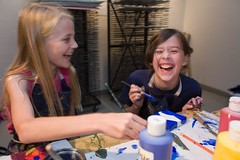There is much talk about student empowerment, engagement, and choice, and yet many education institutions stick to the topics and content required by the curriculum. But not all schools!
One such New Zealand school, inspired by the Google 20% time as (for teachers and students) included the concept in their ICT strategic plan. If you are not familiar with 'Google time' what the company do is empower their employees for 20% of their time at work to work on projects and interests of their own, and for the other 80% they complete the work that has been assigned to them.
Having included it in their ICT strategic plan, the Deputy Principal (DP) and one of the teachers decided to use the model with the students.Having settled on this they felt that one day a week student-directed learning might be too much for their 8 and 9 year old students to manage effectively, so they reduced it to 10% (half a day). The DP "organised the children into pairs and let them choose a topic that they were interested in. Students came up with two or three big questions and what they would do to find the answers. These were then fine-tuned by conference and a learning contract entered into and signed. At this point they still had to decide how to present their findings to the class".
"Students usually work on their projects from 11am until 3pm Thursday and includes independent work in class, in the library, in the computer suite and on netbooks (with a teacher roving between). Some have also worked at home. Topics vary, from V8 cars to the Empire State Building, from the rainforest to Coca Cola, giraffes to tunnels. Some children have made models/dioramas, slideshows, another group has created a movie, added commentary and made music in Myna. Some have their information and answers but have yet to decide on a final presentation format, but the teachers have ever confidence that they'll get there. For the most part students have totally taken over their learning and, in some cases, have become teachers - sharing their skills with their peers (mostly computer skills)... powerful learning :-). Obviously the teachers are always there, to guide, to question, to prompt, but rarely to direct or instruct. Of course they respond to "how do I?" or how can I?" questions, but not before asking other students if they can help first."
"A group of four boys work with more teacher supervision, partly because of their place on the learning path, partly because of their still developing self-management skills, but they are still researching their chosen topic, albeit with more teacher support in questioning, research and next steps".
The teacher who described this initiative said that he had "never seen students so keen, so engaged in topics and interests that they’ve chosen themselves". He goes on to say that: "What we, the teachers, have come to realise is that to really engage and motivate our students 10% time should slowly evolve into 90% time and that we need to take a step back from instruction and become mentors, guides and facilitators."

It was inspirational finding out about something that was so very effective. Time and again in my own experience I've been overwhelmed with what learners have come up with...frequently in ways that I would not have envisaged. Sometimes, yes, there are students who choose not to engage, but this is their choice and respects where they are in their life and aspects of it that I am not privvy to.
So, I'm all for the 90%...with teachers, parents and the wider community (local and international) taking on the roles of mentors, guides and facilitators. It did start me wondering though what a curriculum / assessments would look like in the 90% approach? Something rather different than is currently the case I suspect. And, how do we get to the 90%????








No comments:
Post a Comment